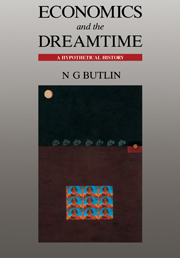Book contents
- Frontmatter
- Contents
- Preface
- Acknowledgements
- Figures
- Maps
- Tables
- Introduction
- Part I The palaeoeconomic history of Aboriginal migration
- Part II Development, structure and function of Aboriginal economy
- Part III Disease, economics and demography
- Part IV The establishment of a bridgehead economy: 1788–1810
- Part V The takeover process: 1788–1850
- 19 Introduction
- 20 British development in the long run
- 21 The hunter gatherers of empire
- 22 British, American and Macassan presence in the takeover
- 23 The major players
- 24 Aborigines and British law
- 25 The economics of takeover
- 26 The composition and demographic impact of disease
- 27 The interaction of disease with resistance, integration and submission
- 28 Conclusions
- Bibliography
- Appendix 1 Preliminary model/checklist of Aboriginal migration to Australia
- Appendix 2 NOAA depth contour maps
- Index
24 - Aborigines and British law
Published online by Cambridge University Press: 06 July 2010
- Frontmatter
- Contents
- Preface
- Acknowledgements
- Figures
- Maps
- Tables
- Introduction
- Part I The palaeoeconomic history of Aboriginal migration
- Part II Development, structure and function of Aboriginal economy
- Part III Disease, economics and demography
- Part IV The establishment of a bridgehead economy: 1788–1810
- Part V The takeover process: 1788–1850
- 19 Introduction
- 20 British development in the long run
- 21 The hunter gatherers of empire
- 22 British, American and Macassan presence in the takeover
- 23 The major players
- 24 Aborigines and British law
- 25 The economics of takeover
- 26 The composition and demographic impact of disease
- 27 The interaction of disease with resistance, integration and submission
- 28 Conclusions
- Bibliography
- Appendix 1 Preliminary model/checklist of Aboriginal migration to Australia
- Appendix 2 NOAA depth contour maps
- Index
Summary
For both the British and the Aborigines, conventional law dealt with property rights and relations between individuals and groups (Castles, 1982; Hanks and Keon-Cohen, 1984; Williams, 1987). In the British case, it was supposed to be declared, knowable and capable of enforcement (granted any physical difficulties of policing). So far as Aborigines were concerned, law was customary, not written, and handed down gradually between generations. For both groups, international law and law relating to conquest were obscure issues.
Whatever other matters may have been involved, law relating to land rights was fundamental as the basis for Aboriginal hunting and gathering, the location of sacred sites and hence the foundation of much of their ritual. British entry into Australia inevitably impinged, to say the least, on those land rights. In fact, British acknowledgement of indigenous land rights was an obscure legal matter. Moreover, there was a basic problem of interpretation of the appropriate action to be taken as between centralised British (Whitehall) authority and colonial British authority. British (Whitehall) professions that they sought to protect the welfare of ‘the natives’ conflicted with their action to enter and occupy Aboriginal areas. British colonial authority dealt with both Whitehall and the immediate processes of resource transfer from Aborigines to local settlers, to whom British (Whitehall and colonial) authority to occupy land was given.
For their part, Aboriginal land areas belonged to traditional occupiers, a word that British entry made ambiguous.
- Type
- Chapter
- Information
- Economics and the DreamtimeA Hypothetical History, pp. 202 - 204Publisher: Cambridge University PressPrint publication year: 1993



